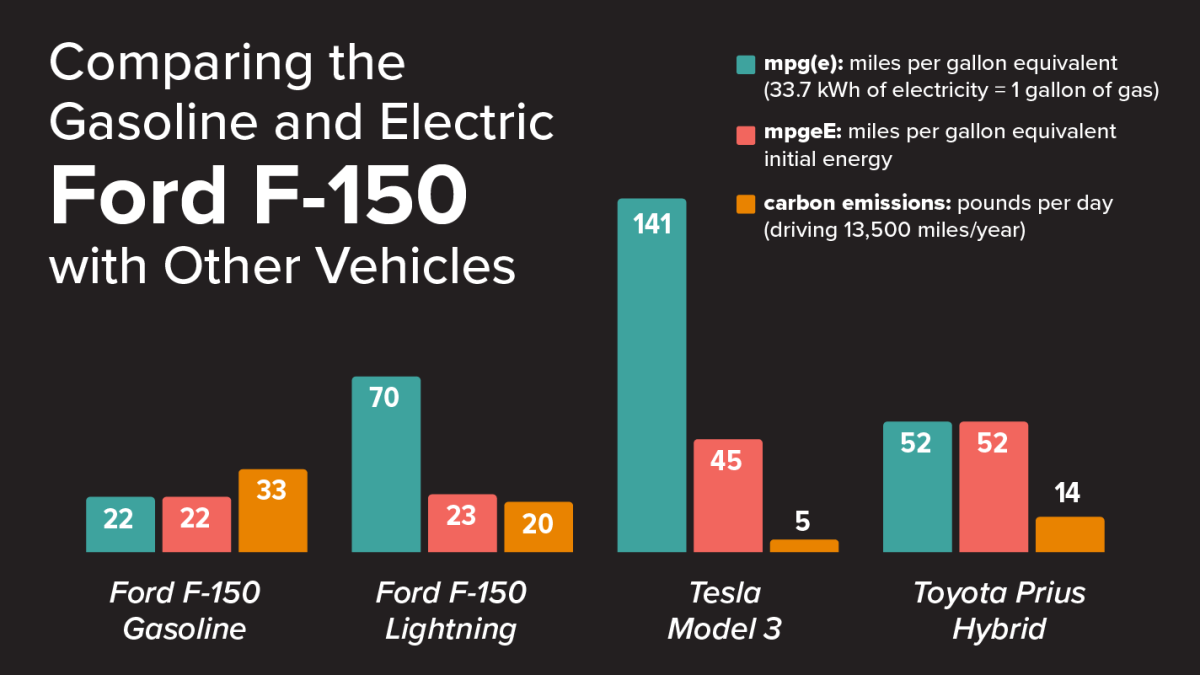The Ford F-150 is the most popular vehicle in the U.S., so interest is high on the electric vehicle (EV) "Lightning" model. EVs are great for several reasons, including no tailpipe emissions, convenience to recharge at home, and a quiet and efficient power train. But do EVs really emit less carbon dioxide (CO2) per mile than our gasoline internal combustion engine (ICE) cars? Well, the short answer is… maybe. It depends on what EV or gasoline engine cars you would drive, and how much CO2 the vehicles emit due to their different energy sources and vehicle efficiencies. Let me explain, starting with energy use.
EVs are rated in miles per gallon equivalent, or mpge, while gasoline engine cars use per gallon (mpg). EV performance seems fantastic if you directly compare these ratings. For example, a Tesla Model 3 has an impressive 141 mpge, while the new Ford F-150 EV truck is expected to be much lower at 70 mpge. These are impressive compared to 25 mpg for an average car in the U.S. But should we directly compare the mpg and mpge? No.
The mpge tells us how far the car can go on the electricity energy equal to a gallon of gas (33.7 kWh), not the energy used to make that electricity which includes fossil fuels and therefore carbon emissions at the power plant. For context, the average U.S. home uses 30 kWh a day of electricity. But how much energy and fossil fuels were used to make that electricity?
Charging an EV battery with 1 kWh requires about 3.1 kWh due to power plant, transmission, and battery charging losses. Including those losses into our EV rating means that Tesla becomes a 45 mpgeE (the E is added to indicate it is based on initial energy), and a Ford F-150 EV is 23 mpgeE. Because we account for energy to make electricity, we can directly compare mpg and mpgeE ratings. The result is that both EVs use more energy than a gasoline-powered hybrid Toyota Prius rated at 52 mpg.
| mpg | miles per gallon |
| mpge | miles per gallon equivalent (1 gallon of gasoline = 33.7 kWh of electricity) |
| mpgeE | miles per gallon equivalent initial energy (This includes all of the production, transmission, and charging losses required to charge an EV battery. Charging an EV battery with 1 kWh requires about 3.1 kWh.) |
What about a comparison of the gas and EV F-150 trucks? The Ford F-150 is rated at 22 mpg (depending on the specific model) using gasoline. This is essentially the same as the F-150 EV with 23 mpgeE. Why are these two vehicles so close in energy use? The electric motor is very efficient compared to a car engine, but it takes more energy to move around the heavier EV. So, about the same energy is required to move those two trucks over the same number of miles.

Now we can determine how much CO2 is emitted from these vehicles. We can estimate how much CO2 is released from burning a gallon of gas, or from making electricity in the U.S., and calculate total emissions. The result? The good news is that the F-150 EV will emit 40% less CO2 than the gasoline-powered F-150 truck, but it emits more CO2 than a gasoline powered hybrid Prius or Tesla EV. If you drive a U.S. annual average of 13,500 miles, your F-150 truck will emit 33 pounds of CO2 per day but that is reduced to 20 pounds of CO2 per day using the EV. You would emit only 14 pounds of CO2 per day using a gasoline powered hybrid Prius, and as little as 5 pounds of CO2 per day using the Tesla. For context, you release about two pounds of CO2 from the carbon in your fuel (food) that you eat every day.
Want to reduce your vehicle emissions to zero? Buy some solar panels (or green electricity from the grid). You need only six to seven solar panels for the Tesla driven 13,500 miles annually in Pennsylvania compared to 22 needed for an average U.S. house. For the EV truck, you could go zero emissions if you got about 13 solar panels. Bottom line: go EV but do that with your own home solar energy!





